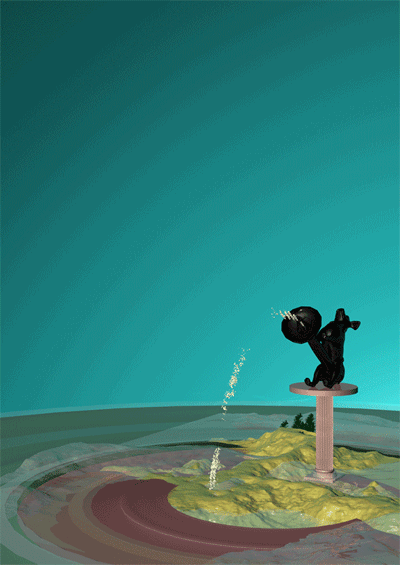Synthetic Assistants

I wrote a short piece for Grafik Magazine’s Screenshot feature: Moravec’s Paradox states that ‘low-level’ sensorimotor skills require far more computational resources than ‘high-level’ abstract reasoning. In general terms, this translates into the doctrine that computers are very good at solving some types of problems, humans at others. Picking out the face of a loved one in a packed crowd […]
GIFbites at بیت بر ثانیه / Bitrates

Shiraz Art House • Daralhokoomeh Project • May/June 2014 As part of Bitrates – an exhibition curated by Morehshin Allahyari and Mani Nilchiani at the Dar-ol-Hokoomeh Project, Shiraz, Iran – I asked 50 artists to create or curate an animated GIF with a short snippet of audio, to be looped together ad infinitum at GIFbites.com. For the opening of Bitrates on May 23rd a select version […]
Black Diamond

I was commissioned to write the essay for Mishka Henner‘s solo show, Black Diamond, at Carroll/Fletcher Gallery, London. The exhibition will run until 31st May, 2014. Excerpt from the essay : If linear perspective centred the World on the Earthly beholder – rendering the artist, viewer or owner of a painting as master of all […]
Internet of Our Dreams

Internet of my dreams was Anthony Antonellis’ solo show at Transfer Gallery, in March 2014. At the conclusion of the exhibition, a digital panel convened around a series of topics that had informed the exhibition. Eleven panelists were invited to participate by moderators Anthony Antonellis and Arjun Ram Srivatsa. The discussions took place online over the course of two days […]
Conference Panel: ‘Exaptation and the Digital Now’
College Art Association annual conference, New Media Caucus affiliated panel ‘Exaptation and the Digital Now’, with Zara Dinnen, Rob Gallagher and Alex Myers, Chicago, February 14th 2014
Artist Profile: Morehshin Allahyari

 Daniel Rourke: Your ongoing project, Dark Matter, was something of a revelation for me: a collection of objects forbidden or “unwelcome” in Iran, brought together through digital modelling, meshing, and 3D printing. The results are playful and surrealistic, with the same capacity to waken the subconscious as any Dali Lobster-Telephone or Hair-Lamp. For me Dark Matter resonates as subversive not just because the dog-dildo is an affront to conservative sexual values, or because the Barbie-VHS blurs cultural boundaries (a feature of a lot of your work). Rather I was taken by how the objects spoke to the here and now; that perhaps there is something about the collapse of all commodities, forms, and ideas into the digital that promotes blurred perspectives and subversive practices. I wondered whether you saw your work as particular to the digital tools and materials you choose, or are you “just” making use of things that happen to be available to you?
Daniel Rourke: Your ongoing project, Dark Matter, was something of a revelation for me: a collection of objects forbidden or “unwelcome” in Iran, brought together through digital modelling, meshing, and 3D printing. The results are playful and surrealistic, with the same capacity to waken the subconscious as any Dali Lobster-Telephone or Hair-Lamp. For me Dark Matter resonates as subversive not just because the dog-dildo is an affront to conservative sexual values, or because the Barbie-VHS blurs cultural boundaries (a feature of a lot of your work). Rather I was taken by how the objects spoke to the here and now; that perhaps there is something about the collapse of all commodities, forms, and ideas into the digital that promotes blurred perspectives and subversive practices. I wondered whether you saw your work as particular to the digital tools and materials you choose, or are you “just” making use of things that happen to be available to you?
Morehshin Allahyari: I was particularly interested in choosing the most relevant tools and materials for creating a new body of work about forbidden/unwelcome objects. I found the idea of “3D printing/re-creating the forbidden” a very compelling prospect, which raised paradoxical issues of limitations and boundaries—social, cultural, and political. I was also very interested in the technology of 3D printing as this “poetic technology” for resistance, for reclaiming all the things that were taken from me during my life in Iran or are currently being taken away from my sister, and mother, and my friends. There is something very special about things that you can’t have access to when they are forced by law out of your life. When there are many of those objects/things, and they are the most ordinary things (dog, sex toys, neck-tie, Barbie, satellite-dish, Bart Simpson, ham/pig, alcohol, etc.), then there is something meaningful and symbolic about using a technology like 3D printing to re-create them. The combination of the objects, I think, adds a sense of humor to the work that is very similar to the ridiculousness of having these objects banned when you look at the whole picture.
While developing the project, I really fell in love with thinking about 3D printing as a “documentation tool”… you know, like when you go to historical museums, and they have this whole collection of objects or things that used to be this and that, or had whatever functionality 500 years ago. I thought, what if this could be the archive, the documentation of the life after the 1979 revolution in Iran, the life I lived, and how will it feel to look back at this collection in 20 or 30 years? Also, through combining and re-creating these objects and putting them inside a virtual word, I can re-contextualize and invite the audience to enter the historical dimension of the work… So yeah… I am directly addressing the medium of 3D printing here. Plus, there is a broad conversation of censorship built into the technology of 3D printing as a whole, which actually expands the project to other countries including the United States (I am thinking about the 3D printed, potentially functional gun as one of the first examples).
Apophenia
I wrote an essay for the publication accompanying Alma Alloro‘s solo exhibition, Apophenia, held at Transfer Gallery, New York – January 4th through 25th, 2014. Excerpt from my essay : Alma Alloro’s machines reel and spin in homage to the kinds of correspondences and affects images can make. In the tradition of Oskar Fischinger’s An Optical Poem […]
